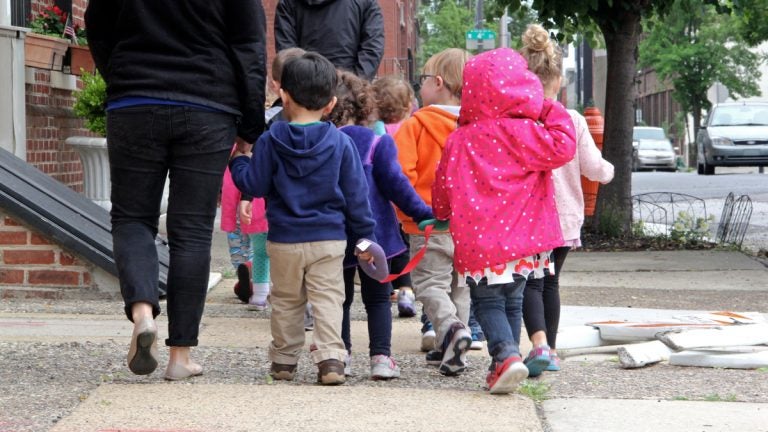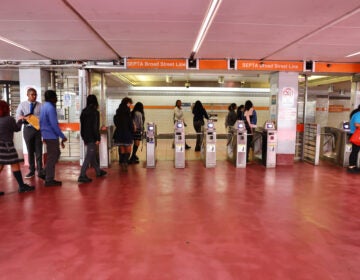Study finds air purifiers significantly improve air quality at Philly day cares
Philly’s asthma rate among kids is almost three times the national average. Researchers say air purifiers could help curb the impact of poor air quality.
Listen 1:16
Children from a Philadelphia day care walking together. (Emma Lee/WHYY)
From Philly and the Pa. suburbs to South Jersey and Delaware, what would you like WHYY News to cover? Let us know!
Omaima Talouli owns and directs Hasan’s Interactive Learning Center, a day care for kids in the Frankford neighborhood of Philadelphia.
Located on the busy Frankford Avenue, Talouli said she’s concerned nearby pollution might have health impacts on the kids who attend her day care — some of whom already have asthma.
A recent study of eight Philadelphia day cares in communities disproportionately impacted by environmental hazards found that air purifiers can significantly improve indoor air quality and reduce fine particle pollution.
“I learned more about how to keep the air circulated and clean for the children,” said Talouli, whose day care participated in the study. “It’s going to help the kids have clean air to breathe, and to reduce the chance of them getting sick.”
The study by the Women for a Healthy Environment, a statewide nonprofit that aims to educate the public about reducing environmental health risks, recommends that day care centers use air purifiers daily, especially in the most vulnerable neighborhoods.
The researchers found that Medify Air Filters, provided to centers free of charge by the Philadelphia Department of Public Health, significantly reduced concentrations of tiny particle pollution known as Particulate Matter 2.5 (PM 2.5), as well as improving Indoor Air Quality (IAQ) levels, particularly when run at high speeds.
“This study’s significance goes beyond child care centers,” said Michelle Naccarati-Chapkis, the organization’s executive director. “By demonstrating the link between improved indoor air quality and potentially reduced health issues, particularly in vulnerable populations, our findings offer valuable insight that can inform public health initiatives in diverse communities.”
Smoke, car fumes, dust, mold, pests and even cooking can produce fine particle pollution, which are smaller than a human hair and easily inhaled. Exposure to PM 2.5 can lead to health problems such as asthma, and children can be particularly vulnerable.
Philadelphia’s asthma rate among kids is almost three times the national average, according to the University of Pennsylvania.
“Children … breathe twice as much air as adults do, and they tend to be much more sensitive to these particles lodging in their lungs because they are growing, and developing, and breathing a lot, so trying to reduce particulates in their space is really valuable,” said Lorna Rosenberg, one of the study’s researchers.
Rosenberg said if child care staff better understand air quality and flow inside their facilities, they can adjust their behavior and schedules to reduce poor air quality impacts.
Among their recommendations, the researchers suggest day cares run air purifiers daily at high speeds, relocate them near kitchens while cooking, replace filters yearly for greater efficacy and invest in air quality sensors.
The researchers say the study highlights that air purifiers can be a worthwhile investment and potentially mitigate health disparities in communities exposed to high levels of pollution.
“No matter how beautiful it may be outside, there’s pollen, there’s dust. There’s all kinds of things that can come inside,” Rosenberg said. “And this, if you can get almost perfect air quality, you should definitely keep these units going all the time.”
High-quality air purifiers can cost up to $200, while air quality monitors can run between $50 and a few hundred dollars.
The researchers also recommend further research into the effectiveness of air purifiers at reducing CO2 levels and humidity, as well as the correlation between improved indoor air quality and reduced respiratory illness.
Melanie Brennan, executive director KenCrest Early Learning Programs, said after participating in the study, her staff will routinely change the air filter and monitor indoor air quality.
“One thing that we learned from COVID is there’s no one strategy, a silver bullet,” she said. “It’s really doing multiple strategies at the same time to keep the environment safe. This is one in the toolbox we have that appears to be pretty effective.”

Get daily updates from WHYY News!
WHYY is your source for fact-based, in-depth journalism and information. As a nonprofit organization, we rely on financial support from readers like you. Please give today.







